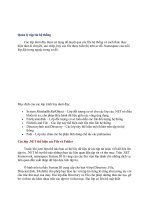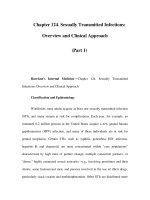BASIC AND CLINICAL DERMATOLOGY - PART 1 pdf
Bạn đang xem bản rút gọn của tài liệu. Xem và tải ngay bản đầy đủ của tài liệu tại đây (786.2 KB, 35 trang )
Cellulite
DK5051_FM.indd 1DK5051_FM.indd 1 1/11/06 11:58:15 AM1/11/06 11:58:15 AM
Process CyanProcess CyanProcess MagentaProcess MagentaProcess YellowProcess YellowProcess BlackProcess Black
BASIC AND CLINICAL DERMATOLOGY
Series Editors
ALAN R. SHALITA, M.D.
Distinguished Teaching Professor and Chairman
Department of Dermatology
SUNY Downstate Medical Center
Brooklyn, New York
DAVID A. NORRIS, M.D.
Director of Research
Professor of Dermatology
The University of Colorado
Health Sciences Center
Denver, Colorado
1. Cutaneous Investigation in Health and Disease: Noninvasive Methods and
Instrumentation, edited by Jean-Luc Lévêque
2. Irritant Contact Dermatitis, edited by Edward M. Jackson and Ronald Goldner
3. Fundamentals of Dermatology: A Study Guide, Franklin S. Glickman and Alan R.
Shalita
4. Aging Skin: Properties and Functional Changes, edited by Jean-Luc Lévêque and
Pierre G. Agache
5. Retinoids: Progress in Research and Clinical Applications, edited by Maria A.
Livrea and Lester Packer
6. Clinical Photomedicine, edited by Henry W. Lim and Nicholas A. Soter
7. Cutaneous Antifungal Agents: Selected Compounds in Clinical Prac tice and
Development, edited by John W. Rippon and Robert A. Fromtling
8. Oxidative Stress in Dermatology, edited by Jürgen Fuchs and Lester Packer
9. Connective Tissue Diseases of the Skin, edited by Charles M. Lapière and Thomas
Krieg
10. Epidermal Growth Factors and Cytokines, edited by Thomas A. Luger and Thomas
Schwarz
11. Skin Changes and Diseases in Pregnancy, edited by Marwali Harahap and Robert
C. Wallach
12. Fungal Disease: Biology, Immunology, and Diagnosis, edited by Paul H. Jacobs and
Lexie Nall
13. Immunomodulatory and Cytotoxic Agents in Dermatology, edited by Charles J.
McDonald
14. Cutaneous Infection and Therapy, edited by Raza Aly, Karl R. Beutner, and
Howard I. Maibach
DK5051_FM.indd 2DK5051_FM.indd 2 1/11/06 11:58:15 AM1/11/06 11:58:15 AM
Process CyanProcess CyanProcess MagentaProcess MagentaProcess YellowProcess YellowProcess BlackProcess Black
15. Tissue Augmentation in Clinical Practice: Procedures and Techniques, edited by
Arnold William Klein
16. Psoriasis: Third Edition, Revised and Expanded, edited by Henry H. Roenigk, Jr.,
and Howard I. Maibach
17. Surgical Techniques for Cutaneous Scar Revision, edited by Marwali Harahap
18. Drug Therapy in Dermatology, edited by Larry E. Millikan
19. Scarless Wound Healing, edited by Hari G. Garg and Michael T. Longaker
20. Cosmetic Surgery: An Interdisciplinary Approach, edited by Rhoda S. Narins
21. Topical Absorption of Dermatological Products, edited by Robert L. Bronaugh and
Howard I. Maibach
22. Glycolic Acid Peels, edited by Ronald Moy, Debra Luftman, and Lenore S. Kakita
23. Innovative Techniques in Skin Surgery, edited by Marwali Harahap
24. Safe Liposuction and Fat Transfer, edited by Rhoda S. Narins
25. Pyschocutaneous Medicine, edited by John Y. M. Koo and Chai Sue Lee
26. Skin, Hair, and Nails: Structure and Function, edited Bo Forslind and Magnus
Lindberg
27. Itch: Basic Mechanisms and Therapy, edited Gil Yosipovitch, Malcolm W. Greaves,
Alan B. Fleischer, and Francis McGlone
28. Photoaging, edited by Darrell S. Rigel, Robert A. Weiss, Henry W. Lim, and Jeffrey
S. Dover
29. Vitiligo: Problems and Solutions, edited by Torello Lotti and Jana Hercogova
30. Photodamaged Skin, edited by David J. Goldberg
31. Ambulatory Phlebectomy, Second Edition, edited by Mitchel P. Goldman, Mihael
Georgiev, and Stefano Ricci
32. Cutaneous Lymphomas, edited by Gunter Burg and Werner Kempf
33. Wound Healing, edited by Anna Falabella and Robert Kirsner
34. Phototherapy and Photochemotherapy for Skin Disease, Third Edition, Warwick L.
Morison
35. Advanced Techniques in Dermatologic Surgery, edited by Mitchel P. Goldman
and Robert A. Weiss
36. Tissue Augmentation in Clinical Practice, Second Edition, edited by Arnold W.
Klein
37. Cellulite: Pathophysiology and Treatment, edited by Mitchel P. Goldman, Pier
Antonio Bacci, Gustavo Leibaschoff, Doris Hexsel, and Fabrizio Angelini
DK5051_FM.indd 3DK5051_FM.indd 3 1/11/06 11:58:15 AM1/11/06 11:58:15 AM
Process CyanProcess CyanProcess MagentaProcess MagentaProcess YellowProcess YellowProcess BlackProcess Black
edited by
Mitchel P. Goldman
University of California
San Diego, California, U.S.A.
and
La Jolla Spa MD
La Jolla, California, U.S.A.
Pier Antonio Bacci
University of Siena
Siena, Italy
and
Cosmetic Pathologies Center
Arezzo, Italy
Gustavo Leibaschoff
University of Buenos Aires School of Medicine
and
International Union of Lipoplasty
Buenos Aires, Argentina
Doris Hexsel
School of Medicine
University of Passo Fundo
Passo Fundo, Rio Grande do Sul, Brazil
Fabrizio Angelini
Endocrinology Service Research Clinic Institute Ecomedica Empoli
Florence, Italy
and
University of Parma
Parma, Italy
Cellulite
Pathophysiology
and Treatment
DK5051_FM.indd 4DK5051_FM.indd 4 1/11/06 11:58:16 AM1/11/06 11:58:16 AM
Process CyanProcess CyanProcess MagentaProcess MagentaProcess YellowProcess YellowProcess BlackProcess Black
Published in 2006 by
Taylor & Francis Group
270 Madison Avenue
New York, NY 10016
© 2006 by Taylor & Francis Group, LLC
No claim to original U.S. Government works
Printed in the United States of America on acid-free paper
10987654321
International Standard Book Number-10: 0-8247-2985-4 (Hardcover)
International Standard Book Number-13: 978-0-8247-2985-1 (Hardcover)
Library of Congress Card Number 2005055997
This book contains information obtained from authentic and highly regarded sources. Reprinted material is quoted with
permission, and sources are indicated. A wide variety of references are listed. Reasonable efforts have been made to publish
reliable data and information, but the author and the publisher cannot assume responsibility for the validity of all materials
or for the consequences of their use.
No part of this book may be reprinted, reproduced, transmitted, or utilized in any form by any electronic, mechanical, or
other means, now known or hereafter invented, including photocopying, microfilming, and recording, or in any information
storage or retrieval system, without written permission from the publishers.
For permission to photocopy or use material electronically from this work, please access www.copyright.com
( or contact the Copyright Clearance Center, Inc. (CCC) 222 Rosewood Drive, Danvers, MA
01923, 978-750-8400. CCC is a not-for-profit organization that provides licenses and registration for a variety of users. For
organizations that have been granted a photocopy license by the CCC, a separate system of payment has been arranged.
Trademark Notice: Product or corporate names may be trademarks or registered trademarks, and are used only for
identification and explanation without intent to infringe.
Library of Congress Cataloging-in-Publication Data
Cellulite : pathophysiology and treatment / edited by Mitchel P. Goldman … [et al.]. p. ; cm. (Basic
and clinical dermatology ; 37)
Includes bibliographical references and index.
ISBN-10: *978-0-8247-2985-1 (hardcover : alk. paper)
ISBN-10: 0-8247-2985-4 (hardcover : alk. paper)
1. Cellulite Pathophysiology. 2. Obesity Pathophysiology. 3. Adipose
tissues Pathophysiology. 4. Obesity Treatment. I. Goldman, Mitchel P. II. Series.
[DNLM: 1. Obesity therapy. 2. Adipose Tissue physiopathology. 3.
Obesity physiopathology. WD 210 C393 2006]
RC628.C42 2006
616.3'98 dc22 2005055997
Visit the Taylor & Francis Web site at
Taylor & Francis Group
is the Academic Division of Informa plc.
DK5051_Discl.fm Page 1 Monday, January 9, 2006 11:18 AM
Series Introduction
During the past 25 years, there has been a vast explosion in new information relating to
the art and science of dermatology as well as fundamental cutaneous biology. Further-
more, this information is no longer of interest only to the small but growing specialty
of dermatology. Clinicians and scientists from a wide variety of disciplines have come
to recognize bot h the importance of skin in fundamental biological processes and the
broad implications of understanding the pathogenesis of skin disease. As a result, there
is now a multidisciplinary and worldwide interest in the progress of dermatology.
With these factors in mind, we have undertaken this series of books specifically
oriented to dermatology. The scope of the series is purposely broad, with books ranging
from pure basic science to practical, ap plied clinical dermatology. Thus, while there is
something for everyone, all volumes in the series will ultimately prove to be valuable addi-
tions to the dermatologist’s library.
The latest addition to the series, volume 37, edited by Drs. Goldman, Bacc i,
Leibaschoff, Hexsel, and Angelini is both timely and pertinent. The editors are well known
authorities in the field of dermatological surgery and cosmetic dermatology. We trust that
this volume will be of broad interest to scientists and clinicians alike.
Alan R. Shalita, M.D.
Distinguished Teaching Professor and Chairman
Department of Dermatology
SUNY Downstate Medical Center
Brooklyn, New York, U.S.A.
iii
Foreword
What exactly is cellulite? Is it a disease or a normal finding in postpubcrtal women? Should it
be treated or ignored? Is it nothing more than a convenient marketing opportunity for cos-
metic manufacturers or something worthy of medical attention? These are but a few of the
controversies surrounding the condition commonly known as ‘‘cellulite.’’ Perhaps the only
point of agreement is that cellulite is unattractive and undesirable. It appears shortly after
the initiation of menstruation in young girls on the upper outer thighs and buttocks and con-
tinues to worsen with the passage of time. Cellulite seems to affect tall and short, fat and
thin, asthenic and curvy females. For many women, cellulite marks the end of the idyllic
youthful body and the onset of the aging, declining female shape. Certainly, there must be
something that technologic medical science can offer. Even in the 1960s, cellulite treatments
abounded with the vibrating belt machines designed to firm the buttock and thighs while
minimizing cellulite. At the time of this writing, there are many creams, devices, and proce-
dures that attempt to deal with the ubiquitous problem of cellulite, but an organized scientific
treatise is lacking.
This text is the first serious evaluation of the etiology and treatment of cellulite. The
editors have assembled an international panel of cellulit e researchers and clinicians to share
their combined knowledge on the subject. The book is nicely organized with an introduction
into the social impact of cellulite, followed by a characterization of the problem through
visual and noninvasive techniques, with a major focus on the various treatment modalities.
Cellulite improvement through the use of topical agents , Endermologie
1
, surgery, lympha-
tic drainage, electroporation, and mesotherapy are investigated by practitioners of each of
the arts. The editors thus provide a full critical evaluation of how each of these treatments
impacts the appearance of cellulite.
Most dermatologists would agree that not a day goes by in clinical practice without a
patient asking about cellulite treatments. To date, it has been difficult to find any reputable
reference source on the subject. This text is a large step forward in characterizing the etiol-
ogy of cellulite and evaluating worthwhile treatment approaches. The editors and their
v
authors should be congratulated for tackling a complex subject and organizing a text to
highlight and discuss the controversies. This book is an illuminating treatise on the cloudy
topic of cellulite.
Zoe Diana Draelos, M.D.
Department of Dermatology
Wake Forest University School of Medicine
Winston-Salem, North Carolina, U.S.A.
vi
&
FOREWORD
Preface
Beauty has been extolled and made a cult object in all cultures and civilizations, whatever their
geographic distribution, ethnic origin, or religion. In ancient Egypt, beauty was associated
with a sacred nature and personified by Queen Nefertiti, a woman who had high brows, wide
and well-delineated eyes, rich lips, a dignified countenance, and an upright bearing, the very
image of subtle energy; the ancient Egyptians regarded beauty closely akin to ‘‘holiness.’’
The Greek aesthetic ideal was characterized by ‘‘perfect proportions’’ in the sense of
the geometric relationships defining body harmony. Aphrodite, the goddess of beauty, was
also worshipped as the goddess of love. Among the Etruscans, the Venus of Melos repre-
sented beauty and harmony; this has remained intact and unpolluted throughout subse-
quent civilizations.
An ancient depiction of the ideal female form.
vii
Etruscan Venus of Melos.
The Three Graces (1640).
Peter Paul Rubens.
viii
&
PREFACE
During the Renaissance, the tall figures of Aphrodite and Venus, slim but muscular at the
same time although somewhat an drogynous, became impres sive an d important, as is evident
in the works of Re m brandt a n d Rubens. T h e beauty o f women was embodied in figures with
abundant localized adiposity, t hough not obese: the faces were round and blissful and expressed
a superb femininity and kindness th at conve y ed the idea of m otherhood and p rotection.
After the French Revolution, the standard represent ation of the woman took a new
turn. The feminine body started to express activity, labor, functionality, precision, and har-
mony, losing some traits of Renaissance femininity. In the new society established after the
Revolu tion, women slowly acquired new roles, carried out new activities, and achieved an
unprecedented independence. As time went by, women even started to smoke cigarette s
and practice sports. There were no objectio ns to this new role as long as the exaggeration
and myths of a sculptured body—such as those characteristic of the 1960s—are avoided.
&
WHY CELLULITE IS A CONCERN FOR US
The disorders characteristic of cellulite involve endocrino-metabolic alterations that affect
the microcirculatory system. They also draw our attention to the functionality and the
cleansing process of the whole organism. Besides, it involves hardly controllable changes
in the locomotor, digestive, and endocrine system. Last, but not least, it is a cause of dis-
comfort and an ill-tolerated lack of aesthetics that drives the patient to accept any type of
so-called therapeutic treatments in order to solve the problem. Too frequently such ‘‘treat-
ments’’ have no scientific basis.
Unfortunately, the ‘‘industrial exploitation of peau d’orange’’ results in permanently
new offerings of therapeutic methods outside the medical sphere. Remedies for this situation
are not simple, but the medical world is accountable for leaving plenty of room for other
actors, perhaps in collusion or motivated by self-interest, but often because no serious scien-
tific research on the physiopathology and therapeutics of cellulite syndromes is available.
Large Reclining Nude (1935).
Henri Matisse.
PREFACE
&
ix
Our efforts should be focused on the recovery of trophism and tissue tone, as well as on
the control of endocrino-metabolic alterations that may entail irrecoverable tissue damage,
not only from an aesthetic point of view. Let us recall, for example, damages resulting from
hard massages on tissues affected by lipolymphedema, those derived from liposuction and
vacuum applied on soft tissues, or from local, uncontrolled application of heat, as well as
those arising from desperate attempts to reduce hip circumference in a few centimeters, a
reduction which is often the evidence of tissue damage rather than of its improvement.
Physicians should be reminded that in their diagnostic activity as well as in therapeu-
tic practice the Hippocratic Oath is still in force: ‘‘Primum, non nocere.’’ This also applies
to paramedical professionals, such as physical therapists, nurses, and podiatrists. Even
those who are not physicians should be highly professional and serious. Their practice
should be guided by sound common sense and be aimed at prevention and health care.
Aesthetic considerations are not unbecoming for the physician and should not be
deemed as such. If it comes to it, we may say they are a kind of sublimated medical attitude
and therefore require still greater professionalism. We should always bear in mind that
ineffective or hardly effective aesthetic treatments have three inescapable consequences:
clinical damage, aesthetic injury and, more frequently, serious psychological damage.
In summary, only within the last three decades has today’s society defined the ideal
female and male body as youthful and almost pre-pubertal. Well-defined muscles with very
little body fat being the ideal. This recent definition of beauty has led to the development
of a new medical ‘‘disease,’’ cellulite.
Cellulite can best be described as a normal physiologic state in post-adolescent
women whose purpose is to maximize adipose retention to ensure adequate caloric avail-
ability for pregnancy and lactation. Almost all women who are not cachectic have cellulite.
The treatment of cellulite is extremely popular in Europe and Latin America. Sales
of various topical therapies in those countries is a multimillion dollar business with an
entire division of ROC (Johnson & Johnson) devoted to its sales and development. Unique
to those countries is the purchasing and development of equipment to treat cellulite. It is
estimated that the sales of cellulite equ ipment is over 10 million dollars each year. This
supports the popularity of awareness of cellulite outside of the United States.
The time is right for a textbook on the treatment of cellulite. Thi s subject is not
taught in medic al schools or in residency programs and there is no textbook in the English
language on this subject. As patients go to their physicians (mostly Cosmetic, Dermatolo-
gic and Plastic surgeons) to seek advice on the pathophysiology and treatment of cellulite,
physicians will need to educate themselves on this subject.
To this end, this textbook represents the work of the world leaders in cellulite
research. We present new ideas to challenge current medical thought on the pathophysiol-
ogy of cellulite as well as a review of many different techniques for its treatment. We hope
this book stimulates an interest in this underserved condition. As in many other fields of
medicine and surgery, the advances in one field may be utilized in other fields. We believe
that this textbook will serve this function.
Mitchel P. Goldman
Pier Antonio Bacci
Gustavo Leibaschoff
Doris Hexsel
Frabrizio Angelini
x
&
PREFACE
&
REFERENCES
1. Curri SB. Liposclerosi e microcircolo. La dermoestetica 1990; 1:6–7.
2. Binazzi M, Papini M. Aspetti clinico istomorfologici. In: Ribuffo, Bartoletti, eds. La cellulite.
Roma: Salus, 1983:7–15.
3. Bartoletti CA, Gualtierotti R. Medicina Estetica. Roma: Salus, 1987.
4. Bartoletti CA. Medicina Estetica. Roma: Salus, 1999.
PREFACE
&
xi
Contents
Series Introduction Alan R. Shalita iii
Foreword Zoe Diana Draelos v
Preface . . . . vii
Contributors . . . . xix
1. Social Impact of Cellulite and Its Impact on Quality of Life . . . . . . . 1
Doris Hexsel and Camile Luisa Hexsel
Introduction . . . . 1
Aspects of Cellulite Related to QOL . . . . 2
Conclusions . . . . 4
References . . . . 5
PART I: DIAGNOSIS OF CELLULITE
2. Definition, Clinical Aspects, Associated Conditions, and Differential
Diagnosis . 7
Doris Hexsel, Taciana de Oliveira Dal’Forno, and Stela Cignachi
Definition . . . . 7
Nomenclature . . . . 9
Clinical Aspects . . . . 9
Differential Diagnosis . . . . 21
References . . . . 24
Appendix . . . . 27
3. Anatomy of Cellulite and the Interstitial Matrix . . . . . 29
Pier Antonio Bacci
Introduction . . . . 29
Cellulite . . . . 29
Interstitial Matrix . . . . 32
References . . . . 38
4. Pathophysiology of Cellulite . . . . . 41
Pier Antonio Bacci and Gustavo Leibaschoff
What Is Cellulite? 41
Definition . . . . 41
xiii
Classification . . . . 43
Evolution . . . . 47
Lipedema and Lipolymphedema: Patholophysiologic
Hypotheses . . . . 50
Lipodystrophy . . . . 57
The Lymphoadipose System . . . . 58
Venous–Lymphatic Stasis . . . . 61
How Cellulite Develops . . . . 62
Manifestations of Cellulite . . . . 62
Clinical Classification . . . . 63
Why Cellulite Is a Concern . . . . 63
Liposclerosis and Localized Adiposity . . . . 63
Etiopathogenic Factors . . . . 68
The Term ‘‘Cellulite’’ . . . . 70
References . . . . 72
5. Diagnosis . . . . 75
Gustavo Leibaschoff
Patient History . . . . 75
Clinical Examination . . . . 75
Laboratory Investigations . . . . 80
ROM Test . . . . 81
Primary Instrument Examinations . . . . 82
Secondary Instrument Examinations . . . . 86
Photography . . . . 88
Diagnosis . . . . 88
Therapeutic Strategy . . . . 95
Medical History . . . . 95
References . . . . 97
Appendix A . . . . 98
Appendix B . . . . 101
6. Cellulite Characterization by High-Frequency Ultrasound and
High-Resolution Magnetic Resonance Imaging . . . . . . 105
Bernard Querleux
Introduction . . . . 105
Materials and Methods . . . . 105
Results . . . . 108
Discussion . . . . 112
References . . . . 114
7. Clinical–Therapeutic Classification: BIMED–TCD . . . 115
Pier Antonio Bacci and Gustavo Leibaschoff
Introduction . . . . 115
Binazzi’s Classification . . . . 115
Curri’s Classification . . . . 116
xiv
&
CONTENTS
Bartoletti’s Classification . . . . 116
BIMED Classification . . . . 117
BIMED–TCD Classification . . . . 127
Pathophysiological Classification and Protocols of
BIMED–TCD . . . . 130
Edematous Cellulite . . . . 131
Adipose Cellulite . . . . 134
Interstitial Cellulite (Lipedema) . . . . 135
Fibrous Cellulite . . . . 137
Summary . . . . 139
References . . . . 140
8. Medical Treatment of Cellulite . . . 143
Gustavo Leibaschoff
Introduction . . . . 143
Abstracts of Studies in Cellasene
1
146
New Research About the Use of Cellasene
1
or Cellulase Gold
1
147
References . . . . 153
9. Theory and Working Principles of Beautytek
Ò
in Cosmetic Medicine 155
Valerio Genitoni
10. Topical Management of Cellulite . . 159
Doris Hexsel, Debora Zechmeister do Prado, Jaggi Rao,
and Mitchel P. Goldman
Introduction . . . . 159
Definition and Nature of Cellulite . . . . 160
Pathophysiologic Mechanisms of Cellulite Formation . . . . 160
Topical Management . . . . 161
Conclusion . . . . 168
References . . . . 169
11. The Role of Endermologie
Ò
in Treatment of Cellulite . 171
Pier Antonio Bacci
Introduction . . . . 171
Anatomy and Physiology . . . . 173
Adipose Tissue and Lipoderma . . . . 176
The Superficial Fascia . . . . 177
Massage . . . . 178
Manual Lymphatic Drainage . . . . 178
The Technique ‘‘Endermologie
1
’’ . . . . 178
Indications . . . . 181
Method . . . . 182
Conclusions . . . . 185
References . . . . 186
CONTENTS
&
xv
12. The Use of TriActive
TM
in the Treatment of Cellulite . 189
Anju Pabby and Mitchel P. Goldman
Mechanism . . . . 189
Review of Cellulite . . . . 189
Parameters . . . . 189
Initial Studies . . . . 190
Other Uses . . . . 191
Contraindications . . . . 191
Protocol . . . . 191
13. Carboxytherapy . . . . . . 197
Gustavo Leibaschoff
Introduction . . . . 197
Indications . . . . 198
Treatment Method . . . . 201
Conclusions . . . . 207
References . . . . 209
14. Surgical Treatment
A: Lipoplasty, Vibro-Assisted Liposuction, Lipofilling,
and Ultrasonic Hydroliposuction . . 211
Gustavo Leibaschoff
Lipoplasty . . . . 211
Historical Background . . . . 212
B: VASER
Ò
220
Alberto Di Giuseppe
Definition . . . . 222
Fat Tissue Vascularization . . . . 223
Patient Selection . . . . 223
Prescriptions . . . . 228
Postoperative Scheme . . . . 229
Conclusion . . . . 230
C: Vibro-Assisted Liposuction . . . . 231
Pier Antonio Bacci, M. Scatolini, P. Belardi, S. Leonardi, and
S. Mancini
Introduction . . . . 231
Lipoplasty . . . . 232
Lipolymphosuction . . . . 232
The Vibro-Assisted Method . . . . 232
D: Lipofilling . 234
S. V. Savchenko, Marlen A. Sulamanidze, and George M. Sulamanidze
Lifting . . . . 236
Liposhifting . . . . 237
xvi
&
CONTENTS
E: Ultrasonic Hydrolipoclasis (External Ultrasound) . . 239
Maurizio Ceccarelli
Cavitation . . . . 242
Biological Effects . . . . 242
Technique . . . . 244
References . . . . 248
15. Subcision
Ò
251
Doris Hexsel and Rosemari Mazzuco
Introduction . . . . 251
Indications and Mechanisms of Action . . . . 251
Contraindications for Subcision
1
254
Preoperative Consultation . . . . 254
Surgical Technique . . . . 254
The Postoperative Period . . . . 257
Complications . . . . 257
Conclusions . . . . 260
References . . . . 262
16. Mesotherapy in the Treatment of Cellulite . . 263
Gustavo Leibaschoff and Denise Steiner
A Brief History . . . . 263
The Concept . . . . 263
Action Mechanism of Mesotherapy . . . . 264
Benefits and Advantages of the Method . . . . 265
Materials and Techniques . . . . 266
General Indications for Mesotherapy . . . . 267
Mesotherapy in Cellulite . . . . 267
Uses for Mesotherapy . . . . 270
What Is Mesotherapy? 271
Why Are Drugs Injected into the Skin? 271
What Drugs Are Used? 271
Which Drugs Should Be Used and How Should They Be
Administered? 272
Drugs and Products Used in Mesotherapy . . . . 277
No-Needle Mesotherapy
TM
282
Conclusion . . . . 283
References . . . . 284
17. Manual Lymphatic Drainage . . . . 287
Gustavo Leibaschoff
References . . . . 290
CONTENTS
&
xvii
18. The Role of Dermoelectroporation . 291
Pier Antonio Bacci
Introduction . . . . 291
Transderm
1
Method . . . . 292
Characteristic Features . . . . 292
Possible Uses . . . . 293
Dermoelectroporation Treatment . . . . 293
Clinical Study . . . . 294
Conclusions . . . . 297
References . . . . 298
19. Lipodissolve for Body Sculpting . . 301
Martin Braun
Introduction . . . . 301
Phosphatidylcholine (PC) . . . . 302
Deoxycholate (Deoxycholic Acid) . . . . 305
Availability of Lipostabil
1
in the United States and Canada . . . . 306
Contraindications for Lipodissolve Injections . . . . 307
Side Effects of Lipodissolve Injections . . . . 307
Dosages and Techniques for Lipodissolve Injections . . . . 309
General Considerations for Lipodissolve Injections . . . . 309
Lipodissolve Formulae for Fat Pad Dissolution . . . . 310
Procedure for Injecting Lipodissolve into Fatty Pads . . . . 312
Clinical Examples of Lipodissolve Therapy . . . . 313
Lipodissolve Summary: Simple Injections for Fat Reduction . . . . 313
References . . . . 322
Index . . . . 323
xviii
&
CONTENTS
Contributors
Pier Antonio Bacci University of Siena, Siena, Italy and Cosmetic Pathologies
Center, Arezzo, Italy
P. Belardi Department of Nuclear Medicine, Privat Hospital Santa Chiara,
Florence, Italy
Martin Braun Vancouver Laser and Skin Care Center, Vancouver,
British Columbia, Canada
Maurizio Ceccarelli Rome, Italy
Stela Cignachi School of Medicine, Lutheran University of Brazil (ULBRA)
of Rio Grande do Sul, Canoas, Rio Grande do Sul, Brazil
Taciana de Oliveira Dal’Forno Medical Sciences, Federal University of Rio Grande
do Sul, Porto Alegre, Rio Grande do Sul, Brazil
Alberto Di Giuseppe University of Ancona, Ancona, Italy
Debora Zechmeister do Prado Doris Hexsel Dermatologic Clinic, Porto Alegre,
Rio Grande do Sul, Brazil
Valerio Genitoni Universita
`
di Urbino, Urbino, Italy
Mitchel P. Goldman University of California, San Diego, California and La Jolla
Spa MD, La Jolla, California, U.S.A.
Doris Hexsel School of Medicine, University of Passo Fundo, Passo Fundo,
Rio Grande do Sul, Brazil
Camile Luisa Hexsel Internal Medicine, Henry Ford Hospital, Detroit,
Michigan, U.S.A.
Gustavo Leibaschoff University of Buenos Aires School of Medicine, and
International Union of Lipoplasty, Buenos Aires, Argentina
S. Leonardi Bacci Medical Center, Arezzo, Italy
xix
S. Mancini Surgery School, University of Siena, Siena, Italy
Rosemari Mazzuco Doris Hexsel Dermatologic Clinic, Porto Alegre, Rio Grande
do Sul, Brazil
Anju Pabby American Academy of Cosmetic Surgery Fellow Trainee and La Jolla
Spa MD, La Jolla, California, U.S.A.
Bernard Querleux Department of Physics, L’Ore
´
al Recherche, Aulnay-sous-bois,
France
Jaggi Rao American Academy of Cosmetic Surgery Fellow Trainee and La Jolla
Spa MD, La Jolla, California, U.S.A.
S. V. Savchenko Moscow, Russia
M. Scatolini Department of Nuclear Medicine, Privat Hospital Santa Chiara,
Florence, Italy
Denise Steiner Mogi das Cruzes University, Mogi das Cruzes, Sao Paulo, Brazil
Marlen A. Sulamanidze Moscow, Russia
George M. Sulamanidze Moscow, Russia
xx
&
CONTRIBUTORS









